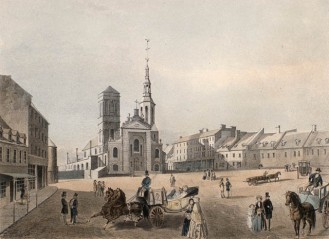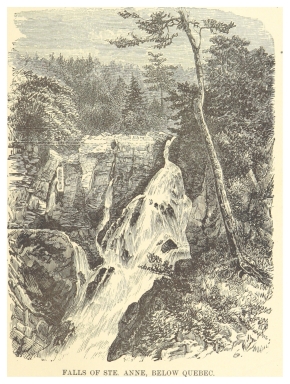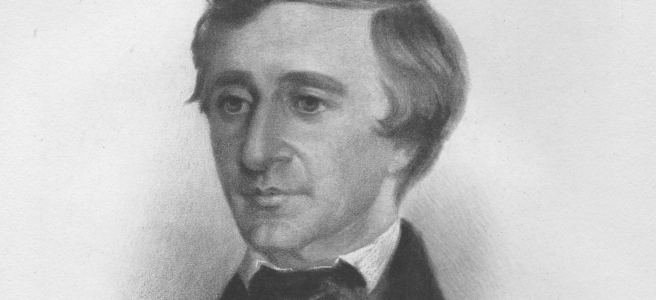Patrick Lacroix
It was a paradox of the age that, as national boundaries hardened and central state authority grew from the late 1830s to the 1850s, continental integration accelerated. The advent of the railway era and the expansion of telegraph lines increased cross-border encounters between British North America and the United States. These technologies created novel economic opportunities, facilitated expatriation, and forced intercultural exchanges on an entirely new scale.
Enter Henry David Thoreau, the Massachusetts writer who famously went to Walden. In his native Concord and beyond, Thoreau was a first-hand witness to these sweeping technological changes. If he lamented the material concerns of the age, he did not forsake all that these changes wrought. In August 1850, Thoreau boarded a train bound for Canada. His nine-day excursion with friend Ellery Channing, Thoreau’s only trip outside of the United States, exposed the possibilities and misunderstandings attendant to increasingly sustained contact between vastly different cultures.

Alternately, from Boston, locomotives and steamboats brought Thoreau, Channing, and hundreds of fellow Yankees to Burlington, Vermont, St. John’s on the Richelieu River, Montreal, and Quebec City. In A Yankee in Canada, an account largely written after the fact, Thoreau shared impressions of the environment he found in the St. Lawrence River valley, as we might expect from the author of Walden. With greater focus, he also offered his American readers a portrait of the men and women he had encountered.
In Thoreau’s hands, French Canadians were a people of little intelligence or sophistication. They were superstitious and idolatrous; light-hearted, lazy, and lacking in the spirit of improvement. At last they evinced no sense of civic virtue. Thoreau’s measure, of course, was the free (but not carefree), rational, enterprising, and republican Yankee.
It may be tempting to identify the Anglo-Saxon Protestant as his model. Many observers who relegated French Canadians to a subaltern position did so on a purely ethnic or racial basis. This was indeed a recurrent theme throughout the North American Anglosphere for the better part of a century. It was taken up with little change by Francis Parkman, Goldwin Smith, the New Englanders who faced la grande saignée, and some of Canada’s most notable historians. It had indeed appeared along the same lines in Lord Durham’s report in the 1830s.
But Thoreau’s overarching framework was not racial – it was ideological. There may therefore be greater cause to excuse Thoreau relative to the other authors. The Yankee writer did not attribute French Canadians’ failings to inherited traits. The people of the St. Lawrence River valley were victims not of nature, but of corrupt institutions. Relentlessly, he assailed the Catholic Church and Britain’s military establishment, Old World institutions that explain depictions of the country as medieval throughout A Yankee in Canada. The habitants had been reduced to a child-like state. They were now unlikely to emancipate themselves, though by doing so, by casting off physical and intellectual shackles, they might meet the high measure of human fulfilment that Thoreau proposed.
Thus, in 1850, Thoreau brought a post-revolutionary credo to Canada East. Geographically and philosophically, he retraced the steps of the Patriots of 1775-1776 who had sought to make of these Canadians enlightened republican citizens. Through the page the modern reader can almost hear Thoreau cry out, ‘Ecrasez l’infâme!’ as he slips by priests and nuns on the streets of Montreal. But, arguing that an American would immediately revolt here, in the face of British garrisons, he also echoed the battle cry of a prior era, ‘Give me liberty or give me death!’ In Canada, history had failed to turn.
Thoreau’s account – the expression of an American political worldview more than an honest sociological study – first appeared in print in 1853. A definitive version was published posthumously in 1866. Since then, A Yankee in Canada has attracted little scholarly attention on either side of the border. The oversight is a strange one, considering the primary line of debate that has animated Quebec historians for the better part of the last sixty years.

This debate, which Ronald Rudin captures perfectly as “the search for a normal society,” has occurred around the fundamental questions of revolution and republicanism. We find here a historiographical paradox: the scholars closest to Thoreau’s assessment have been secular nationalists eager to show that reactionary forces checked the development of “healthy” progressive and democratic impulses in Quebec. Some argue that Quebec, as a nation, is still searching for itself after centuries of oppression, is still a victim. This view is alive and well.
The outsider’s gaze that we find in A Yankee in Canada sheds light on this narrative and on its origins. It suggests renewed scrutiny of the measure of modernity presented by Thoreau and his unsuspecting latter-day followers. In both instances, national mythmaking has tended to obscure certain structural forces that significantly complicate the tale of institutional(ized) oppression.
The nuns, priests, and soldiers of Thoreau’s account help to conceal the revolution of economic development. Surely, as he sat on the steamer Lord Sydenham, on his return journey, Thoreau could appreciate the material advances sweeping through Canada. Soon, continental integration would attain its supreme expression with the Treaty of Reciprocity. French Canadians would take the same railway as Thoreau had and settle in American industrial cities by the hundreds of thousands, eventually becoming citizens of the Great Republic. The Yankee writer also omitted the political events of the prior fifteen years, not least insurrections inspired by the American Revolution and the implementation of responsible government. These were inconvenient facts in Thoreau’s linear, Whig-style narrative, which stressed national differences in order to justify the fruits of a republican ideology.
Partly because it is so selective, Thoreau’s account invites greater reflection on Quebec’s américanité – its centuries-old relationship to the United States, its own American character, and the ways in which scholars, educators, journalists, and other observers have framed these issues. Superb work has been accomplished from transnational and continental perspectives. Enriched by a century and a half of hindsight, A Yankee in Canada now reveals potential risks in this line of enquiry. By searching for a normative américanité – a model that creates normal and abnormal societies – we too may encourage the distortions of nationalistic mythmaking rather than transcending them.
Patrick Lacroix is a Ph.D. candidate at the University of New Hampshire. His research has lately appeared in the International History Review and in the Catholic Historical Review. His study of Thoreau’s travels in Canada East will appear in the fall 2017 issue of the American Review of Canadian Studies.
Title Image: Portait of Henry David Thoreau in 1854, by Samuel W. Rowse. Wikimedia Commons.

4 thoughts on “Henry David Thoreau, French Canada, and l’Américanité”